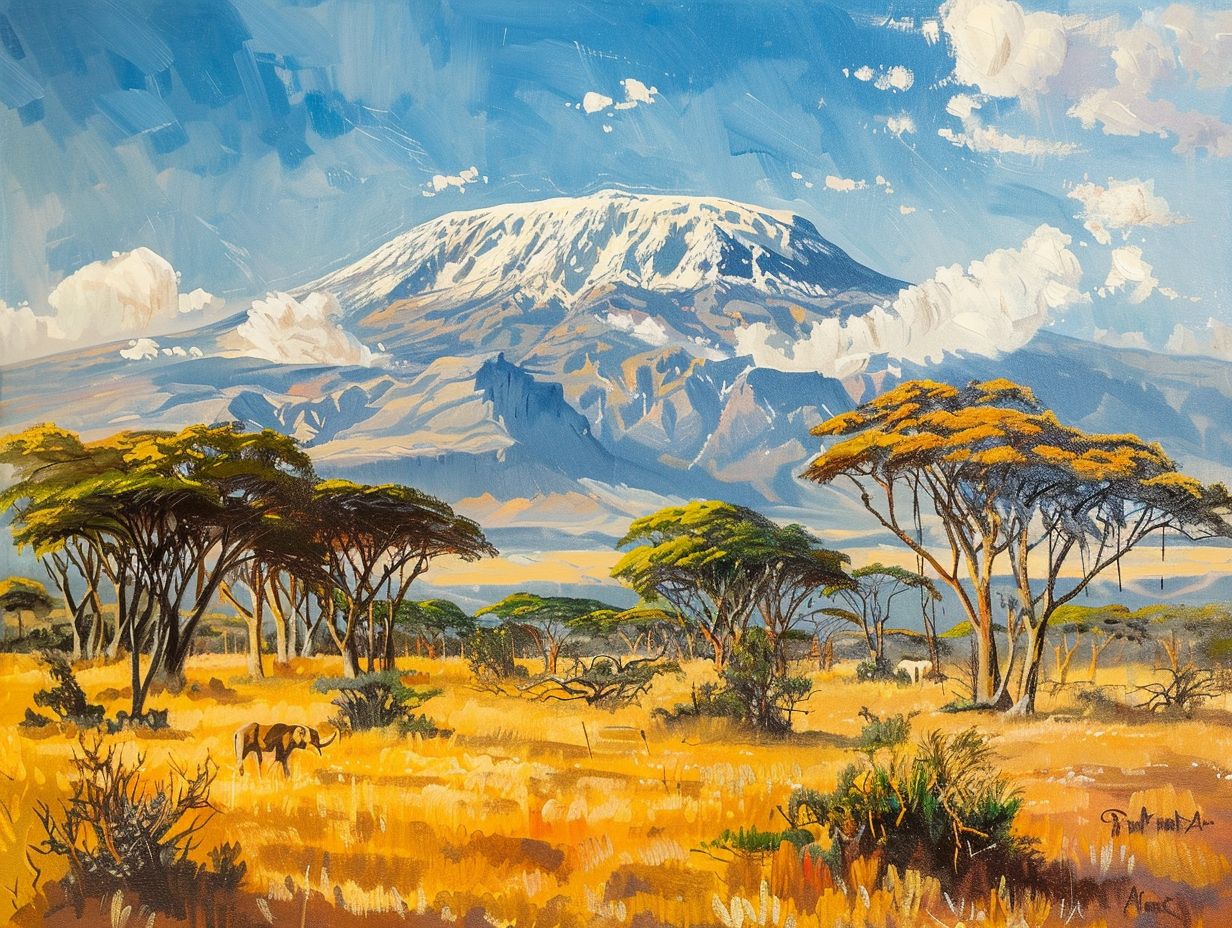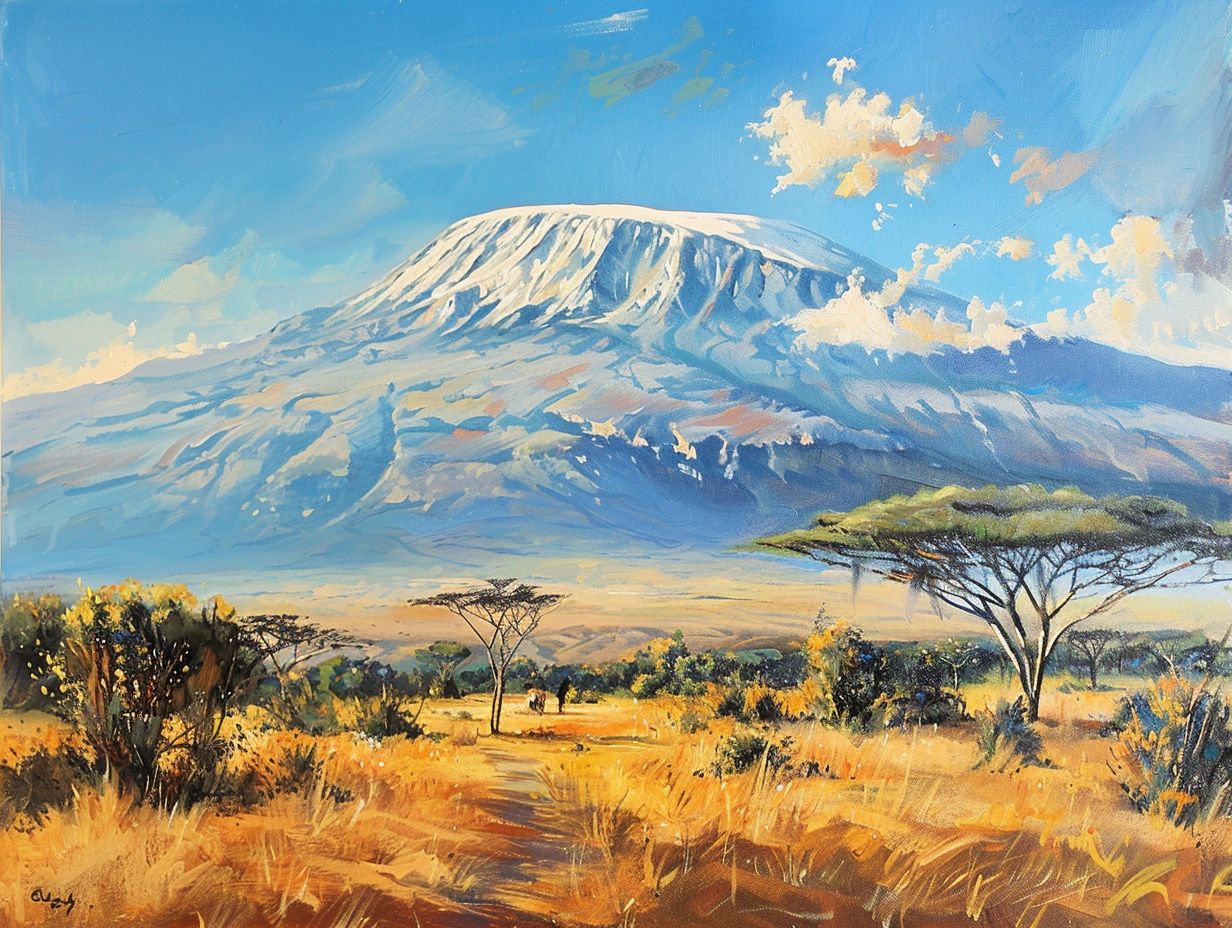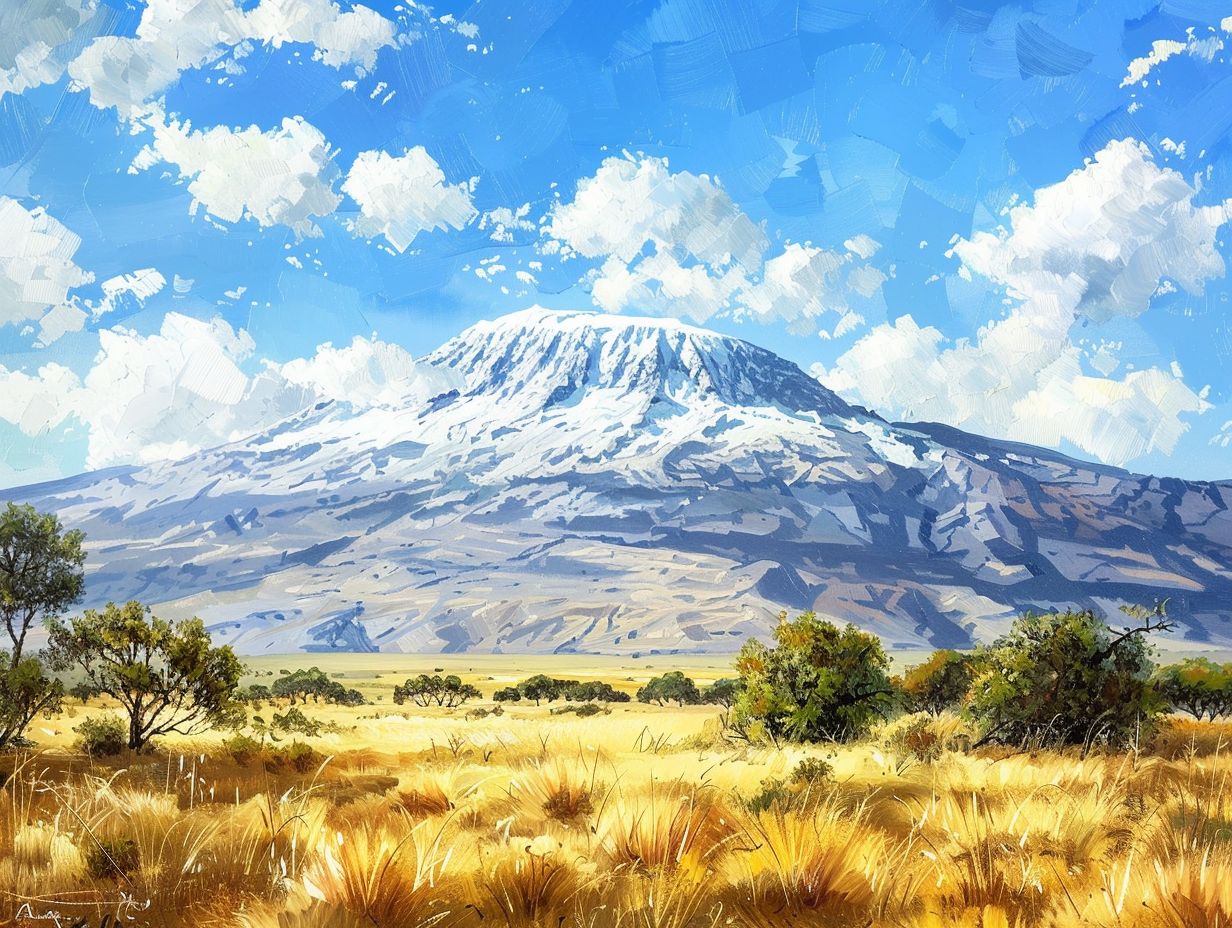
Kilimanjaro Meaning
Discover the rich cultural and geographical significance of Kilimanjaro, the iconic mountain located in Tanzania. From the origin of its name to its impact on the local Chagga, Maasai, and Swahili people, Kilimanjaro holds a special place in the hearts of many.
Explore the religious, spiritual, and economic importance of this majestic peak, as well as the environmental concerns and controversies surrounding it. Join us on a journey to uncover the mysteries of Kilimanjaro.
Key Takeaways:

- Kilimanjaro is a famous mountain located in Tanzania, Africa.
- The name Kilimanjaro has its roots in the local Chagga, Maasai, and Swahili cultures, each with their own unique interpretations.
- Aside from its geographical significance, Kilimanjaro holds great cultural and spiritual importance for the people of Tanzania and has a significant economic impact as well.
What Is the Meaning of Kilimanjaro?
The meaning of Kilimanjaro traces back to its Swahili origins, with various theories surrounding the name’s etymology and significance. Named by the Chagga people and later influenced by the Maasai and European explorers like Krapf and the Germans, Kilimanjaro’s name holds a rich history that intertwines linguistic, cultural, and geographical elements.
At its core, ‘Kilimanjaro’ is believed to come from the Swahili words ‘Kilima’ and ‘Njaro’, representing ‘hill’ and ‘shining’ respectively, symbolizing the awe-inspiring snow-capped peak. The Chagga people, who have long called the mountain ‘Kilema Kyaro’, have their interpretation as ‘we failed to climb it’.
Over time, the Maasai reference the mountain as ‘Ol Doinyo Oibor’ meaning ‘white mountain’, emphasizing its snowy peak. European involvement in the name’s evolution introduced variations and complexities, shaping the mountain’s identity and heritage.”
-
Origin of the Name:
The origin of the name Kilimanjaro is a subject of intrigue and cultural amalgamation, stemming from its Swahili roots and the influence of the Chagga people in naming the majestic mountain. European explorers like Krapf further contributed to the name’s evolution and adoption within the global lexicon.
It is fascinating to delve into the intricate dynamics between indigenous naming practices and the external influences that shaped Kilimanjaro’s identity over time.
Swahili culture bestowed the mountain with its initial name ‘Kilima Njaro,’ meaning ‘shining mountain,’ capturing the awe-inspiring beauty of this natural wonder. The Chagga people, who have resided near the mountain for centuries, added their touch to the nomenclature, incorporating their customs and beliefs into the mountain’s name.
-
The Chagga People:
The Chagga people, indigenous to the Kilimanjaro region, have a deep-rooted history intertwined with the mountain, encompassing myths, legends, and traditional names that reflect their cultural connection to the towering peak.
This relationship between the Chagga and Mount Kilimanjaro goes beyond mere geography; it delves into the realm of spirituality and shared ancestry. Mount Kilimanjaro is not just a physical presence in their lives; it embodies a cultural identity, a source of pride and reverence for the Chagga community.
Stories passed down through generations speak of their forefathers seeking solace and wisdom from the mountain’s slopes, shaping a collective consciousness that honors the mountain as a sacred entity.
-
The MaasZai People:

The Maasai people, renowned for their rich cultural heritage and nomadic traditions, have also contributed to the mythology and nomenclature associated with Kilimanjaro, infusing the mountain with symbolic meanings and historical significance.
One captivating aspect of the Maasai’s perspective on Kilimanjaro is their belief that the mountain is home to the God Ngai, a central figure in their spiritual beliefs.
According to Maasai folklore, Ngai resides on the summit of Kilimanjaro, watching over the land and its people.
This mythological connection has shaped the reverence that the Maasai hold for the mountain, influencing their rituals and ceremonies that are performed in its shadow.
-
The Swahili People:
The Swahili people, known for their vibrant culture and linguistic contributions, have left an indelible mark on Kilimanjaro’s toponymy and regional identity, shaping the mountain’s name and historical narrative through their language and heritage.
One of the most intriguing aspects of the influence of the Swahili people on Kilimanjaro’s naming conventions is the rich tapestry of meanings encapsulated in the Kiswahili names assigned to various locations on the mountain. Each name carries with it a story, reflecting not just geographical features but also cultural perceptions and historical events.
This linguistic tapestry weaves together a narrative that goes beyond mere labels, offering a deeper connection to the mountain’s past and the people who have revered it for generations.
The Swahili heritage has had a profound impact on how Kilimanjaro is perceived globally. The mountain’s association with the Swahili language and culture has added layers of depth and authenticity to its portrayal in literature, art, and popular culture.
This infusion of Swahili heritage has transformed Kilimanjaro from a mere geographical landmark into a symbol of cross-cultural exchange and mutual respect, showcasing the beauty and significance of diversity in our shared human experience.
What Is the Cultural Significance of Kilimanjaro?
Kilimanjaro holds multifaceted cultural significance, serving as a religious, spiritual, and economic touchstone for diverse communities such as the Chagga, Maasai, and those residing near the Shira region. The mountain’s presence is woven into the fabric of local traditions, beliefs, and livelihoods.
For the Chagga community, Kilimanjaro is not just a physical entity but a sacred site believed to house spiritual beings and deities. They perform rituals and ceremonies to honor the mountain’s power and seek blessings for their crops and livestock.
On the other hand, the Maasai people see Kilimanjaro as a symbol of beauty and strength, often incorporating its imagery into their traditional dances and songs during important ceremonies.
-
Religious and Spiritual Importance:
Kilimanjaro’s towering presence has long been revered for its religious and spiritual significance, with various rituals, ceremonies, and belief systems attributing sacred qualities to the mountain, making it a focal point for spiritual journeys and communal practices.
Among the Chagga people, Kilimanjaro is considered the seat of Ngai, the Sky God, whose presence imbues the mountain with divine energies. Pilgrimages to the summit are seen as a way to connect with the divine and seek blessings for health, prosperity, and protection.
The Maasai view Kilimanjaro as a bridge between the Earth and the heavens, a place where spiritual energies flow freely. The mountain thus becomes a sacred ground for initiation ceremonies, vision quests, and other spiritual practices that seek harmony with nature and the supernatural.
-
Cultural Traditions and Practices:
Kilimanjaro’s cultural tapestry is rich with diverse traditions, practices, and ceremonies that reflect the deep-rooted heritage of local communities and their enduring connections to the mountain. These rituals embody a blend of history, symbolism, and communal identity.
One of the most intriguing aspects of the cultural traditions surrounding Kilimanjaro is the way in which the ceremonies, celebrations, and heritage events encapsulate the mountain’s significance within various cultural contexts. These events serve as crucial milestones that unite communities and reinforce their ties to this majestic natural landmark.
Through the preservation of cultural legacies tied to Kilimanjaro, communities strive to maintain the authenticity and vibrancy of their ancestral practices. This dedication ensures that future generations can continue to experience and appreciate the deep-rooted traditions that have been passed down through centuries.
-
Economic Impact:
Kilimanjaro’s economic impact extends beyond its cultural value, encompassing tourism revenues, local livelihoods, and conservation efforts that rely on the mountain’s allure as a premier destination. The economic sustainability of the region is intricately linked to the mountain’s ecological and touristic appeal.
The flow of visitors to Kilimanjaro not only contributes to the economic vitality of the area but also presents a unique set of challenges and opportunities for sustainable development.
Balancing the influx of tourists with the need to protect the natural environment poses a delicate balance. Investing in local communities and ensuring they benefit from tourism activities in a fair and equitable manner are crucial aspects of fostering sustainable economic growth in the region.
What Is the Geographical Significance of Kilimanjaro?

The geographical significance of Kilimanjaro is underscored by its presence within the Mount Kilimanjaro National Park, a UNESCO World Heritage Site that showcases the mountain’s ecological diversity, geological formations, and distinctive landscapes. Situated in the expansive Great Rift Valley, Kilimanjaro serves as a beacon of biodiversity and conservation excellence.
Encompassing an area of approximately 755 square kilometers, Mount Kilimanjaro National Park is home to not only Africa’s highest peak but also a remarkable array of ecosystems, ranging from montane forests to alpine deserts. This diverse landscape offers a haven for numerous plant and animal species, some of which are endemic to the region.
The mountain’s geological features, including its three volcanic cones – Kibo, Mawenzi, and Shira – add to its allure, providing a glimpse into the earth’s geological history. Kilimanjaro’s glaciers, although diminishing due to climate change, are vital water sources for the surrounding communities and wildlife.
Conservation efforts within the park are crucial for preserving this rich biodiversity, with initiatives focused on sustainable tourism, reforestation projects, and habitat protection. By maintaining the delicate balance of its ecosystems, Kilimanjaro continues to inspire awe and serve as a testament to the importance of environmental stewardship.
-
Mount Kilimanjaro National Park:
The Mount Kilimanjaro National Park stands as a testament to the ecological richness and conservation value of the region, designated as a UNESCO World Heritage Site to protect the diverse flora, fauna, and habitats that thrive in the shadow of the majestic mountain.
Located in Tanzania, this park covers an area of approximately 756 square kilometers encompassing not only the iconic Mount Kilimanjaro but also a range of ecosystems such as montane forests, moorlands, alpine deserts, and savannah plains.
These diverse habitats support a remarkable array of wildlife, including the endangered elephant, buffalo, eland, leopards, and various species of monkeys. The park’s strict conservation efforts have contributed significantly to the protection of these animals and their habitats, ensuring a sustainable environment for generations to come.
-
The Great Rift Valley:
Kilimanjaro’s location within the Great Rift Valley, an expansive geological trench that stretches across East Africa, accentuates the mountain’s unique geological formation and historical significance in the context of tectonic movements and landform evolution.
The formation of Kilimanjaro can be traced back to the tectonic activities associated with the East African Rift system. The Great Rift Valley, where Kilimanjaro is situated, is a result of the divergent tectonic forces that have been reshaping the region for millions of years.
This geological activity has not only influenced the creation of Kilimanjaro but has also given rise to a diverse range of landforms, including volcanic peaks, deep valleys, and extensive lakes.
-
Biodiversity and Conservation:
Kilimanjaro’s biodiversity and conservation efforts are crucial for safeguarding the mountain’s unique ecosystems, habitats, and endemic species that thrive in the diverse altitudinal zones of the region.
These conservation strategies are designed to address the various threats posed by human activities such as deforestation, climate change, and illegal poaching. By implementing protected areas, sustainable land management practices, and community-based conservation projects, stakeholders aim to ensure the long-term survival of the rich flora and fauna found in this UNESCO World Heritage Site.
The delicate balance of the montane forests, alpine meadows, and moorlands on Kilimanjaro faces challenges from population pressure and resource exploitation, making it imperative to promote eco-friendly tourism and raise awareness of the importance of environmental sustainability.
What Are the Challenges and Controversies Surrounding Kilimanjaro?
Kilimanjaro faces a myriad of challenges and controversies, ranging from environmental concerns related to glacier retreat and ecosystem degradation to the impacts of tourism-driven overcrowding and the complexities of addressing cultural appropriation issues within the region.
One of the primary environmental threats to Kilimanjaro is the rapid loss of its iconic glaciers due to climate change, posing not just a visual loss but also disrupting local water systems and biodiversity. This disappearance of glaciers can significantly impact the region’s hydrological balance, affecting both wildlife and local communities that rely on the mountain’s resources.
The surge in tourism, while bringing economic opportunities, has also led to issues like waste accumulation, resource depletion, and conflicts with indigenous communities over land use. Finding a sustainable balance between promoting tourism and preserving the mountain’s fragile ecosystem remains a delicate task that requires thoughtful planning and collaboration.
The question of cultural appropriation arises as Western climbers often romanticize and commodify the Maasai and Chagga cultures surrounding Kilimanjaro, sometimes without proper respect or understanding.
This highlights the need for responsible and ethical tourism practices that respect the local customs and traditions of the people living in the region to ensure a harmonious relationship between visitors and the local communities.
-
Environmental Concerns:
Environmental concerns surrounding Kilimanjaro are deeply rooted in the phenomenon of glacier retreat, the degradation of ice cores, and the broader impacts of climate change on the mountain’s fragile ecosystems and hydrological cycles.
As the glaciers on Kilimanjaro continue to shrink, the once pristine ice fields are losing their volume and surface area at an alarming rate, disrupting the delicate balance of the mountain’s ecology. Studies have shown how the retreat of these glaciers not only affects the availability of freshwater resources downstream but also alters local weather patterns and biodiversity.
Scientific research on Kilimanjaro’s changing environment plays a crucial role in understanding the underlying causes of these ecological shifts. By analyzing ice cores, researchers can unravel the mountain’s climatic history and assess the extent of human-induced climate change impacts.
-
Tourism and Overcrowding:

The surge in tourism activities on Kilimanjaro has led to concerns about overcrowding, environmental degradation, and the sustainability of climbing expeditions to the summit, particularly the iconic Uhuru Peak. Balancing conservation with tourism demands remains a critical challenge for preserving the mountain’s allure.
Overwhelmed by the sharp increase in visitors each year, Kilimanjaro faces severe issues such as trampled vegetation, accumulation of waste, and strain on local resources.
The delicate alpine ecosystem around the peak is under immense pressure due to the influx of climbers and support staff. Efforts to manage waste and regulate expedition sizes have been implemented to reduce ecological stress, but more sustainable practices are urgently needed to safeguard the mountain’s fragile environment.
-
Cultural Appropriation:
The discourse on cultural appropriation surrounding Kilimanjaro revolves around the complexities of heritage preservation, indigenous knowledge recognition, and the respectful representation of local identities in the face of external influences and commercial interests linked to the mountain.
One of the central themes in this discourse is the tension between the external portrayal of Kilimanjaro and the authentic lived experiences of the indigenous communities who have maintained strong connections to the mountain for generations.
Respectful engagement with local cultures demands a nuanced understanding of their significance, practices, and beliefs. Cultural commodification and misrepresentation can erode the integrity of these traditions and perpetuate harmful stereotypes.
It is crucial to acknowledge the agency of indigenous peoples and involve them as active participants in decision-making processes regarding Kilimanjaro-related initiatives.
Frequently Asked Questions:
1. What is the meaning of Kilimanjaro?
A: Kilimanjaro is a Swahili word that translates to “shining mountain” or “white peak”. It is the name of a dormant volcano in Tanzania, Africa.
2. What does Kilimanjaro symbolize?
A: Kilimanjaro is often seen as a symbol of strength, resilience, and beauty. It represents the natural wonders of Africa and the human spirit’s ability to overcome challenges.
3. Why is Kilimanjaro called the “Roof of Africa”?
A: Kilimanjaro is the highest mountain in Africa, standing at 19,341 feet. Due to its towering height, it is often referred to as the “Roof of Africa”.
4. Is there any cultural significance to Kilimanjaro?
A: Yes, Kilimanjaro holds great cultural significance to the Chagga people who live around the mountain. It is considered a sacred site and has many cultural rituals and beliefs associated with it.
5. What is the history of Kilimanjaro’s name?
A: Kilimanjaro was originally known as “Kilemanjaru” by the Wachagga people. However, when the German explorer, Hans Meyer, reached the summit in 1889, he recorded the name as “Kilimanjaro”, which eventually became the accepted spelling.
6. Are there any legends or stories about Kilimanjaro?
A: Yes, there are many legends and stories about Kilimanjaro, including one that tells of a powerful spirit living at the top of the mountain. It is said that whoever disturbs this spirit will be cursed with bad luck.